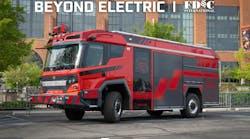Since 911 was introduced as the North American emergency number in 1968, billions of calls for assistance have been made. In fact, according to recent statistics, people in the United States dial these three digits over 500,000 times on an average day. As the volume of calls increases, the infrastructure continues to age.
Designed around technology that is approaching its 40th birthday, much of the 911 network is becoming outdated; especially in comparison with the more modern consumer electronic systems that it is now called on to support. If they were fire apparatus, many of the critical 911 components would have been long retired. Instead, they remain in front-line service. And, while they work, they are increasingly becoming dinosaurs in this age of digital media.
Part of the driving force behind the Next Generation 911, or NG 911 as it has come to be called, are the myriad features of telephony that have found their way into everyday life. Text messaging and video phones are but two of many examples that will have a profound effect on emergency reporting, but that are not currently supported. Telematics is another. While private sector companies like On-Star and ATX offer data-enhanced communications, the public sector has been slow to embrace the ability to receive such information.
As we progress in the 21st century, we find ourselves attempting to flow volumes of data through the equivalent of booster lines, when in fact we are facing a challenge that requires large-diameter hose. A detailed size-up of the issues provides a better understanding of the challenges ahead.
Currently, the realm of Telematics is almost exclusively contained within the private sector. Whether included in a new-car purchase or obtained after the fact, Telematics involves the delivery and receipt of data through a monitoring facility. Acting in almost the same fashion as central fire alarm stations, these call centers can track vehicle location, monitor a variety of sensors and even unlock doors. Additionally, they provide value-added services such as providing directions and making reservations for subscribers, and can even track their vehicles should they be stolen.
When it comes to accident and emergency reporting, however, there is a school of thought that favors direct contact between the caller and the responsible Public Safety Access Point (PSAP). (After all, the fewer people involved in relaying information, the better the chances for accuracy and timeliness.) While that contact is normally now voice, under NG 911 it could be voice - and much more. There is almost no end to the amount of data that can be monitored by vehicle sensors; a big-rig driver can now commonly check tire pressure without leaving the cab, for example. But a more promising use for public safety is Automatic Crash Notification (ACN). Using this technology, any vehicle involved in a serious accident would dial 911 itself, reporting a wide number of conditions such as the number of passengers, speed before impact, rollover and airbag deployment. Even if the driver is incapacitated, this data will be automatically routed to the appropriate agency, along with Global Positioning Satellite (GPS) location data.
While there are no corporate statements to support this viewpoint, one may envision a world where profit-based Telematics providers wean themselves from emergency reporting and focus more on concierge-based services. Liability and staffing concerns prompted the telephone companies to abandon publicizing "Dial O for emergencies" years ago, and there is significantly less exposure in sending someone to the wrong restaurant than there is in sending a fire call to the wrong department. In March 2007, On-Star announced that through the General Motors Foundation, it will donate $250,000 toward research by the Centers for Disease Control (CDC) regarding how Telematics can be best used to help ensure survivable crashes. GM plans to equip two million of its 2007 models with advanced Telematics capacity, and to increase this by another 50% in the 2008 model year. Although most users renew their memberships, many do not, and On-Star statistics show that lock-out calls outnumber emergencies by almost three to one. The ability of the 911 network to capture and utilize collision-based data may, in itself, sound the death knell for the privatization of these services. Why pay for what you can get for free?
Taking and sending still photographs and movies with cell phones has become a common practice - so common that many establishments concerned with security ban the open carrying of cell phones on their premises. Websites and even the evening news often display photos and videos captured in this manner. Reporters in Iraq use wireless devices to cover stories where camera crews are unavailable, and disturbing images of the Virginia Tech shootings were obtained by a cell phone camera.
Unfortunately, this common ability does not extend to 911. You may be able to send your friend a snapshot of your new car, but you can't send a picture of the car fire you are reporting to the local dispatcher. New York City is one of several jurisdictions where authorities are trying to tap into this technology; however, these current attempts are not completely seamless. In NG 911, photos and videos will be received concurrently with the voice call and interfaces to computer-aided dispatch (CAD) and Mobile Data Terminals (MDTs) will enable the instantaneous transfer of this information to first responders. If, as they say, a picture is worth a thousand words, embedded images may well prove their value as a means of letting firefighters begin size-up before they even leave quarters.
Another popular feature of cell phones is text messaging. An entire culture has developed surrounding this ability for silent chat. While some schools raise concerns that surreptitiously sharing typed answers could become a means of undetected cheating, others are softening their views in the wake of Virginia Tech, wondering whether voiceless communication may provide a covert means of calling 911 in the presence of danger. But, to the deaf, voiceless communications is not a luxury or a passing fad. It is a necessary way of life. For years, the deaf have used TDDs (Telecommunication Devices for the Deaf) to communicate by telephone. While some of the original fixed units were as big as teletype machines, over time, portable TDDs were developed that were about the size of a laptop. Still, this meant that a deaf person had to carry one of these wherever they went in order to make a phone call, and there have been ongoing compatibility issues between TDDs and wireless access. Enabling 911 to accept text messages would kill both of these birds with a single stone. Boston and Chicago have expressed interest in developing this capacity, but as in the case of New York City, these proposals rely on utilizing the cellular network to augment 911, rather than creating an integrated system as envisioned as the next generation.
Regardless of how we get there; get there we must. A recent survey indicated that a majority of people under the age of 25 do not own a conventional telephone. Twenty-five years ago, wireless telephones weren't even an issue. Another more recent addition to the mix is Voice over Internet Provider (VoIP). Simply put, VoIP uses the Internet to generate dial tone and to allow access to telephone service, including 911. There have been and still are numerous issues with VoIP, including limitations in some communities on true enhanced location services, and the fact that certain Internet phones can operate in both fixed and mobile modes. Given that there are over 750 VoIP providers nationwide, and that the World Wide Web functions in a manner different than the conventional telephone network, it is easy to see how problems can arise.
Still VoIP is not a totally bad thing for public safety. In fact, many PSAPs are installing VoIP-based systems in-house and researching Internet-like networking to provide shared communication. This is because, in the future, a 911 call will not be limited to just voice; it will be a multimedia experience. The equipment required to properly process this increased information must be totally digital and able to transmit packets of data at high speed without cumbersome conversions to and from analog. Emergency dispatch centers in different communities and served by different telephone companies must be able to immediately and seamlessly transfer all of the information associated with an incident to one another; something that often cannot be accomplished now. Technology and protocols developed for data management on the World Wide Web will play a significant role in our immediate future.
On the political front, the U.S. Department of Transportation (DOT) is overseeing a formal NG 911 initiative in conjunction with its Intelligent Transportation Systems (ITS) project. DOT envisions that smart highways coupled with a robust emergency reporting network will greatly improve traffic safety. In April 2007, the Senate Commerce Committee met with public safety communications leaders to discuss the scope and funding of what lies ahead. Comments from many involved echoed concern with the ability of public safety to keep pace with consumer technology. Contributing to past challenges has been 911 legislative language that defined a telephone in terms that are as outdated as our current 911 infrastructure. In a world where portable video games can wirelessly interact, access to 911 is not limited to a hard-wired device with a rotary dial. Jason Barbour, president of the National Emergency Number Association (NENA), expressed a desire to cover all of our bases now. "We do not need to repeat this process every time a new technology comes along," he said.
Wanda McCarley, president of the Association of Public-safety Officials (APCO) International, testified that, "Next Generation 911 systems will ultimately occur within a broader array of interconnected networks comprehensively supporting emergency services; from public access to those services to the delivery of emergency information to call-takers, dispatchers and first responders. This development is an evolutionary process to enable the general public to make a 911 call from any wired, wireless, or Internet Protocol (IP) based device." Earlier in the month, both organizations issued a press release outlining complementary efforts being carried out by NENA and APCO relating to NG 911.
This cooperation, and more, will be required in order to bring about the agreements on standards and methodologies that will result in the long overdue modernization of our 911 system. Forty years ago, when the first 911 call was made, our fathers responded on the backsteps of apparatus, wearing leather helmets and cotton-duck turnout coats. A lot has changed since then, but perhaps nothing has changed more than technology and public expectations. We are facing a new generation of challenges in the fire service, and a new breed of 911 system is required. That breed is Next Generation 911; it's not your father's emergency number.
BARRY FUREY, a Firehouse contributing editor, is director of the Raleigh-Wake Emergency Communications Center in North Carolina. During his 35-year public safety career, he has managed 911 centers and served as a volunteer fire officer in three other states. In 2002, Furey chaired the Association of Public-safety Communications Officials (APCO) International conference in Nashville, TN, and in 2005 he received an APCO life membership for his continued work in emergency communications.





